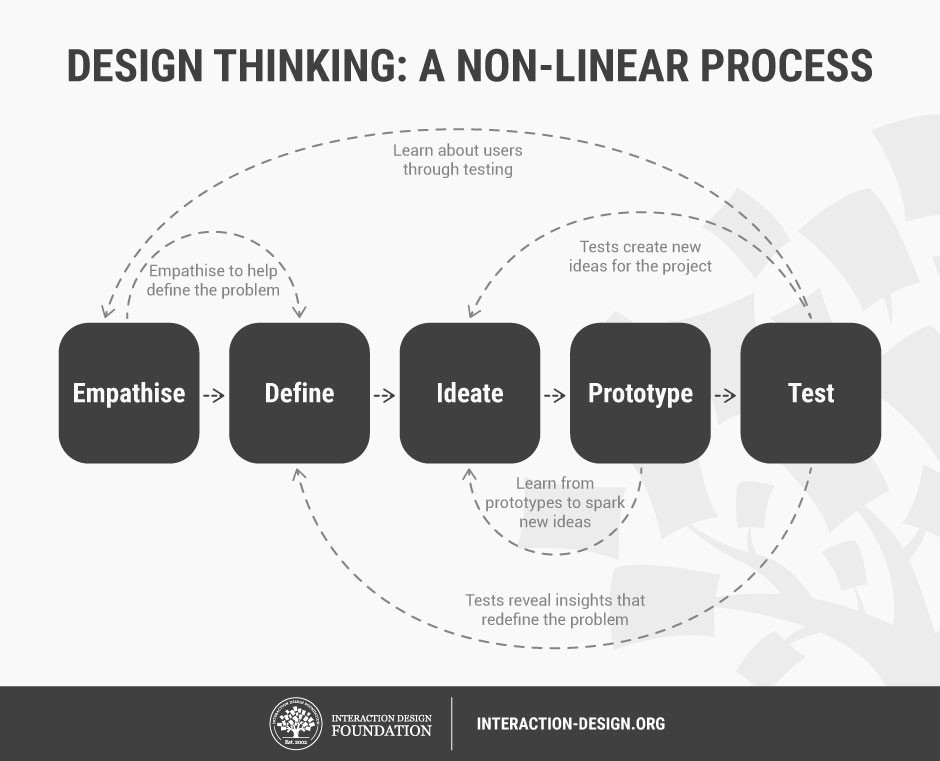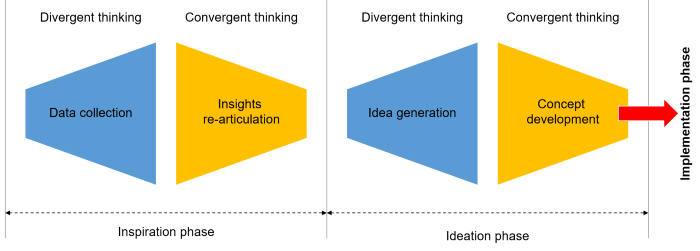Design thinking has exploded in popularity recently as a new way of approaching problems, and coming up with new ways of doing things. Usually applied in fields such as design and UX, it’s influence has seeped into companies like Apple, Google and GE making it a veritable buzzword for marketing and beyond. Design thinking has a process with defined steps but tends to be a bit squiggly (technical term) as some steps help to define the one before and vice versa.

In this blog post we’ll be looking at the third step – ideation, in more detail. As a creative strategist, ideation is a discipline I like to keep sharp and in my back pocket (sounds like a disaster waiting to happen right? Remind me to not mix metaphors again).
What is ideation?
I like to think of it as an algorithm to generate ideas. It gives some structure to a ‘vanilla’ brainstorm, is great for reviving flagging brains and is a fun way to strategise in a group.
The aim of ideation is purely idea generation, which means to say quantity over quality. No matter what an idea is, it gets noted without analysis or judgement. This is a purely numbers game.
Why do you need ideation?
So ideation is great and all, but why waste time brainstorming when we could all go and do some proper work? Well, ideation is a great way to innovate with new ideas. A lesser known benefit is how well it can let you frame and redefine what you may see as ‘problems’ into solutions.
“One man’s problem is another’s solution.” – Me, just now
There is no pressure to find the ultimate solution in an ideation session, instead stupid questions are encouraged. Questions that question the status quo are powerful, and are the first step in challenging long held assumptions about how things are done or have been done in the past. Another great advantage of using ideation is the sheer volume of ideas generated means that you’re statistically more likely to end up with a better solution. In design thinking, ideation is the stage when you stretch divergent thinking muscles, spreading laterally to look beyond obvious answers and broaden possibilities.

Source: Nima Torabi on Medium
How to ideate
So how would one go about running an ideation session? Structure is absolutely critical here, as you want to set everyone involved up for success. Mindset is everything. Ideally you’d have a defined problem or question that you want to address. The next step is assembling a group of different thinkers from different disciplines and a moderator (this will probably be you). A session works best when there are clear rules.
Rule 1: Set times to think about each prompt, and set times for discussion. Short sprints of timed discussion, and alone time work well – a bit like HIIT training.
Rule 2: Someone should be a notetaker, and should write down every idea without question.
Rule 3: There shall be no criticism of ideas. There are no bad ideas, there is no ‘right’ idea, there only exist ideas in a vacuum. Judgement comes later.
Rule 4: The moderator should make sure the above rules are followed, and have a bag of prompts at their disposal to keep things fresh.
Below is a list of ideation techniques, a mixture of prompts and thought experiments to spark grey matter.
Brainstorm:
If brainstorming was an ideation ice cream flavour, it would be vanilla. There’s a reason why it’s so popular, it’s quite good. Brainstorming is coming up with ideas either alone or in a group (whiteboard not mandatory).
Braindump:
To brain dump is to figuratively word vomit on page. Coming out with anything and everything that’s on your mind on the subject, even if it’s not an idea.
Brainwriting / Brainwalking:
This one is a bit like that consequences game you may have played at school. One person starts everyone off with an idea, then the next person adds on their thoughts, building on the original idea and so on. You can either do this with a card that’s passed around or post it notes on a wall to get people moving.
SCAMPER:
This one’s an acronym: Substitute, Combine, Adapt, Modify, Put to another use, Eliminate, Reverse. With each command, take an existing idea or question and apply the action to see if something is activated in your brain.
Mindmap:
Let’s make a diagram! Some people like to think visually and this one’s a great way to map out ideas and show connections and relationships to topics within your subject.
Opportunity redefinition / Semantic Intuition:
A bit like Mad Libs, opportunity redefinition uses the original brief / problem and distills it down to the most important 3 words. Then take those three words, and create columns, filling rows with alternative words and synonyms. The final step is to mix and match these new words to see if anything meaningful happens. Semantic intuition is very similar, taking related keywords instead of words from the brief.
Storyboard:
Tell a story with a template, imagining the idea in video form, whether it’s an ad, tv episode or movie.
Sketch:
Draw a scamp (a rough sketch or mockup of your idea).
Worst possible idea:
Come up with the worst idea you can. Extra points if its bad, stupid, pointless, or illegal.
Challenge Assumptions:
A tricky one to master, but a good’un. Lay out all of the assumptions relating to the subject and try to challenge them. Don’t be afraid to go too simple here – assuming everyone sees the world the same is a big no no!
Analogies:
As someone who loves a good analogy, this technique is a favourite. Try to think about the problem at hand and imagine it in a different situation. If a real life one doesn’t come to mind, make one up.
Interpretive dance / bodystorm:
Move your body, if that moves you. Try to interpret the brief in a physical way. It’s not for everyone.
Gamification:
Try to structure your solutions or ideas like a game, using principles from gamification like progression, levels, points and XP.
Life or death:
If finding a solution isn’t already life or death, up the stakes a little.
Freaky friday / role play:
Swap places for a day with your users or audience or even your clients and role play situations to get new ideas brewing.
Time travel:
Imagine your problem happening in the past, the century is up to you. Conversely try to imagine your problem in the future, does it still exist? Is it better or worse? And why might that be?
Cheatstorm:
This one is like cheating, because it is cheating. Steal someone else’s idea and butcher it to solve your problem.
Crowdsourcing:
Take a look on the internet and see if the collective hive mind has any ideas – twitter is a good place as you can search by hashtags. Reddit is another good springboard.
Wishing:
If wishes were horses… In an ideal scenario what would your idea be, and how would you solve your problem? Wish away and it might come true
Simplify:
Make it as simple as you can, and then even simpler still. You might find a nugget of wisdom.
Megatrends:
Think about trends happening now, both in pop culture and wider society and try to think about your problem in that context to see if there’s any way to link them to a solution.
Digitise:
Think about things that aren’t usually digital in relation to your problem, and make them digital. Take pen and paper online. An interesting twist on this technique is to do it the other way around. How would you take something offline and IRL? Something to ponder perhaps.
Shoot for the moon:
Name the most ridiculous impossible idea that you can think of. You get a bonus if it requires the changing of the laws of physics. From your shoot for the moon idea, you can walk back through the steps to see if you uncovered any wisdom that could help you find something more feasible.
Vitamin / Painkiller / Cure:
This technique is usually used when assessing ideas, but I think it’s a good way to think about generation. A vitamin is an idea that makes something that’s already okay, a bit better, a painkiller is an idea that eases your audience’s pain, and a cure is an idea that eliminates a pain point altogether.
Take a break:
You’ve read this far into this beast of a blog post, so I’m assuming you like to push through things until they’re done. Ideation is not like that so make sure you take regular pauses and breaks.
Personalise:
Be selfish and think about yourself, and come up with ideas that you would personally use.
Market first:
Think about markets that often don’t get attention and try to come up with a solution that caters to them first. Here are some ideas: older people, LGBTQ+, BAME, the list goes on.
This list doesn’t include every ideation technique ever, but I hope there are enough here to get started. The key takeaway here is that people who come up with good ideas naturally tend to use some of these without realising.
Being able to generate solutions at will can be learnt. It’s even easier than learning, there’s a step by step framework here that will enable you to squeeze every bit of brain juice into idea gold. Remember, it’s a numbers game, so the more ideas you can generate the higher the chance you’ll have a good one.

Found is the Everysearch™ agency. Masters of search performance across all digital marketing platforms. Employing PPC, SEO, paid social, and creative content, they harness the power of data and AI to craft and execute winning digital marketing strategies.


